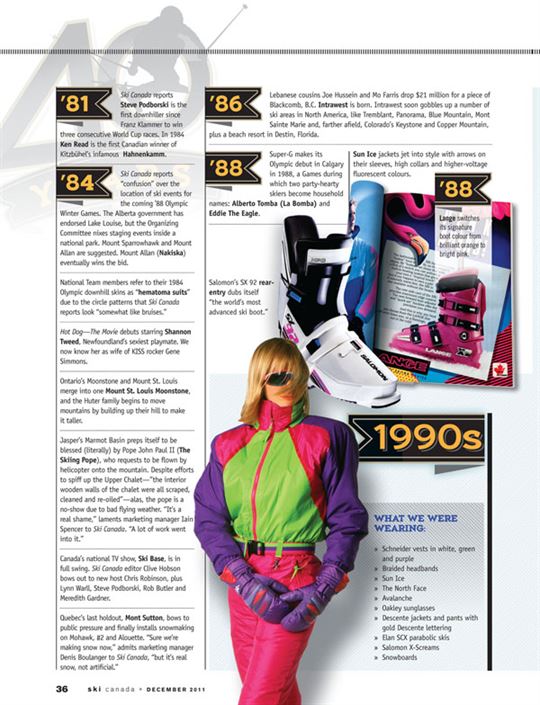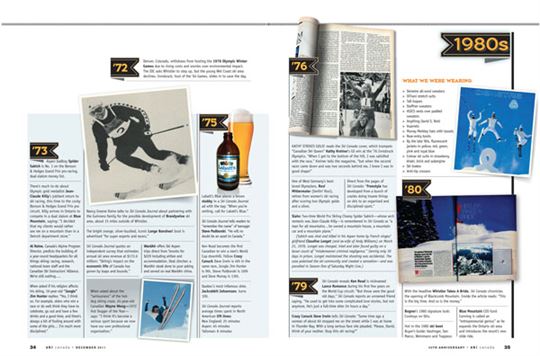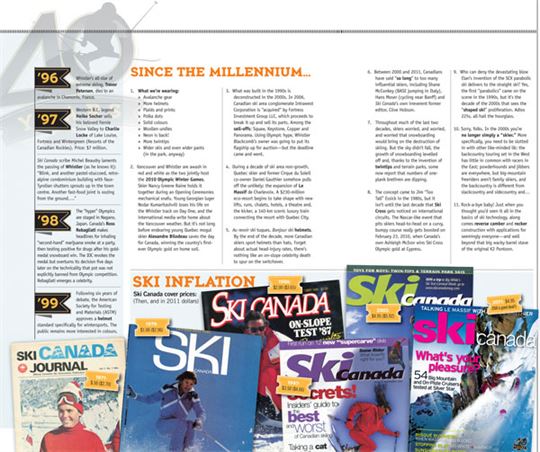A nostalgic flip through the back issues of Ski Canada turned up the silly as well as the serious side of skiing. We’ve come a long way, baby!
BY LORI KNOWLES from December 2011 issue
The very first edition of Ski Canada Journal hits the stands with 21-year-old ski racer Judy Crawford on the cover. Inside the author asks the “very attractive” National Ski Team member telling questions such as: “What is the average age of a lady skier?”
1970s
WHAT WE WERE WEARING: » Blue and red bandanas » Hip-length White Stag parkas » Denim windshirts » Eddie Bauer down masks » Pullover down jackets » Ellesse nylon jumpsuits » Shiny nylon White Stag ski jackets » The wet look » Western-style down vests and cowboy hats » Schneiderhosen stretch pants » DiTrani jackets and bibs » Wigwam legwarmers over jeans » Rooster hats » Pompom hats » Jeans and wineskins » Bogner powder suits » ISKI sunglasses » Scott boots » K2 Cheeseburgers » BURT bindings » Sea & Ski lotion » Safety straps
Triple threat: Ski Canada Journal closes its inaugural edition with who else on the back cover but…Nancy Greene, Mars Bars and Rossi Stratos.
’72
Denver, Colorado, withdraws from hosting the 1976 Olympic Winter Games due to rising costs and worries over environmental impact. The IOC asks Whistler to step up, but the young Wet Coast ski area declines. Innsbruck, host of the ’64 Games, slides in to save the day.
’73
Aspen badboy Spider Sabich is No. 1 on the Benson & Hedges Grand Prix pro-racing, dual-slalom money list.
There’s much to-do about Olympic gold medallist Jean-Claude Killy’s jubilant return to ski racing, this time to the cocky Benson & Hedges Grand Prix pro circuit. Killy arrives in Ontario to compete in a dual slalom at Blue Mountain, saying: “I decided that my clients would rather see me on a mountain than in a Detroit department store.”
Al Raine, Canada’s Alpine Program Director, predicts the building of a year-round headquarters for all things skiing: racing, research, national team staff and the Canadian Ski Instructors’ Alliance. We’re still waiting….
When asked if his religion affects his skiing, 19-year-old “Jungle” Jim Hunter replies: “Yes, I think so. For example, skiers who win a race or do well think they have to celebrate, go out and have a few drinks and a good time, and there’s always a bit of fooling around with some of the girls… I’m much more disciplined.”
Nancy Greene Raine talks to Ski Canada Journal about partnering with the Guinness family for the possible development of Brandywine ski area, about 15 miles outside of Whistler.
The bright orange, silver-buckled, iconic Lange Banshee! boot is advertised “for super experts and racers.”
Ski Canada Journal quotes an independent survey that estimates annual ski area revenue at $172.6 million: “Skiing’s impact on the economic life of Canada has grown by leaps and bounds.”
WardAir offers Ski Aspen trips direct from Toronto for $229 including airfare and accommodation. Deal clincher: a WardAir steak done to your asking and served on real WardAir china.
’75
Labatt’s Blue places a brown stubby in a Ski Canada Journal ad with the tag: “When you’re smiling, call for Labatt’s Blue.”
Ski Canada Journal tells readers to “remember the name” of teenager Steve Podborski. “He will no doubt be an asset to Canada.”
Ken Read becomes the first Canadian to win a men’s World Cup downhill. Fellow Crazy Canuck Dave Irwin is 4th in the same race, Jungle Jim Hunter is 9th, Steve Podborski is 10th and Dave Murray is 13th.
Quebec’s most infamous skier, Jackrabbit Johannsen, turns 100.
Ski Canada Journal reports average times spent in North American lift lines: New England: 25 minutes Aspen: 45 minutes Talisman: 8 minutes
When asked about the “seriousness” of the hot-dog skiing craze, 24-year-old Canadian Wayne Wong—1972 Hot Dogger of the Year— says: “I think it’s become a serious sport becausewe now have our own professional organization.”
’76
KATHY STRIKES GOLD! reads the Ski Canada cover, which trumpets “Canadian Ski Queen” Kathy Kreiner’s GS win at the ’76 Innsbruck Olympics. “When I got to the bottom of the hill, I was satisfied with the race,” Kreiner tells the magazine, “but when the second racer came down and was two seconds behind me, I knew I was in good shape!”
One of West Germany’s best-loved Olympians, Rosi Mittermaier (Smilin’ Rosi), retires from women’s ski racing after scoring two Olympic golds and a silver.
Direct from the pages of Ski Canada: “Freestyle has developed from a bunch of crazies doing insane things on skis to an organized and disciplined sport.”
Slain: Two-time World Pro Skiing Champ Spider Sabich—whose arch nemesis was Jean-Claude Killy—is remembered in Ski Canada as “a man for all mountains…he owned a mountain house, a mountain car and a mountain plane.” (Sabich was shot and killed in his Aspen home by French singer/girlfriend Claudine Longet (and ex-wife of Andy Williams) on March 21, 1976. Longet was charged, tried and later found guilty on a lesser count of “misdemeanor criminal negligence.” Serving only 30 days in prison, Longet maintained the shooting was accidental. The case polarized the ski community and created a sensation—and was parodied in Season One of Saturday Night Live.)
’79
Ski Canada reveals Ken Read is nicknamed Lance Romance during his first few years on the World Cup circuit: “But those were the good old days,” Ski Canada reports an unnamed friend saying. “He used to get into some complicated love stories, but not anymore. He’s just a full-time skier 24 hours a day.”
Crazy Canuck Dave Irwin tells Ski Canada: “Some time ago a woman of about 60 stopped me on the street while I was at home in Thunder Bay. With a long serious face she pleaded, ‘Please, David, think of your mother. Stop this ski racing!’”
1980s
WHAT WE WERE WEARING: » Demetre all-wool sweaters » DiTrani stretch suits » Tall tuques » Steffner sweaters » ASICS vests over padded sweaters » Anything David S. Reid » Vuarnets » Murray Merkley hats with tassels » Rear-entry boots » By the late ’80s, fluorescent jackets in yellow, red, green, pink and royal blue » Colmarski suits in strawberry, khaki, brick and aubergine » Ski brakes » Anti-tip crossers
’80
With the headline Whistler Takes A Bride, Ski Canada chronicles the opening of Blackcomb Mountain. Inside the article reads: “This is the big time. And so is the money.”
Bogner’s 1980 signature look: Cowboys on Skis.
Hot in the 1980 ski boot Buyer’s Guide: Kastinger, San Marco, Weinmann and Trappeur.
Blue Mountain CEO Gord Canning is called an “entrepreneurial genius” as he expands the Ontario ski area and introduces the resort’s new slide ride. 
’81
Ski Canada reports Steve Podborski is the first downhiller since Franz Klammer to win three consecutive World Cup races. In 1984 Ken Read is the first Canadian winner of Kitzbühel’s infamous Hahnenkamm.
’84
Ski Canada reports “confusion” over the location of ski events for the coming ’88 Olympic Winter Games. The Alberta government has endorsed Lake Louise, but the Organizing Committee nixes staging events inside a national park. Mount Sparrowhawk and Mount Allan are suggested. Mount Allan (Nakiska) eventually wins the bid.
National Team members refer to their 1984 Olympic downhill skins as “hematoma suits” due to the circle patterns that Ski Canada reports look “somewhat like bruises.”
Hot Dog—The Movie debuts starring Shannon Tweed, Newfoundland’s sexiest playmate. We now know her as wife of KISS rocker Gene Simmons.
Ontario’s Moonstone and Mount St. Louis merge into one Mount St. Louis Moonstone, and the Huter family begins to move mountains by building up their hill to make it taller.
Jasper’s Marmot Basin preps itself to be blessed (literally) by Pope John Paul II (The Skiing Pope), who requests to be flown by helicopter onto the mountain. Despite efforts to spiff up the Upper Chalet—”the interior wooden walls of the chalet were all scraped, cleaned and re-oiled”—alas, the pope is a no-show due to bad flying weather. “It’s a real shame,” laments marketing manager Iain Spencer to Ski Canada. “A lot of work went into it.”
Canada’s national TV show, Ski Base, is in full swing. Ski Canada editor Clive Hobson bows out to new host Chris Robinson, plus Lynn Warll, Steve Podborski, Rob Butler and Meredith Gardner.
Quebec’s last holdout, Mont Sutton, bows to public pressure and finally installs snowmaking on Mohawk, #2 and Alouette. “Sure we’re making snow now,” admits marketing manager Denis Boulanger to Ski Canada, “but it’s real snow, not artificial.”
’86
Lebanese cousins Joe Hussein and Mo Farris drop $21 million for a piece of Blackcomb, B.C. Intrawest is born. Intrawest soon gobbles up a number of ski areas in North America, like Tremblant, Panorama, Blue Mountain, Mont Sainte Marie and, farther afield, Colorado’s Keystone and Copper Mountain, plus a beach resort in Destin, Florida.
’88
Super-G makes its Olympic debut in Calgary in 1988, a Games during which two party-hearty skiers become household names: Alberto Tomba (La Bomba) and Eddie The Eagle.
Sun Ice jackets jet into style with arrows on their sleeves, high collars and higher-voltage fluorescent colours.
Salomon’s SX 92 rear-entry dubs itself “the world’s most advanced ski boot.” Lange switches its signature boot colour from brilliant orange to bright pink.
1990s
WHAT WE WERE WEARING:
» Schneider vests in white, green and purple » Braided headbands » Sun Ice » The North Face » Avalanche » Oakley sunglasses » Descente jackets and pants with gold Descente lettering » Elan SCX parabolic skis » Salomon X-Screams » Snowboards
’90
Cancer takes out Dave Murray, one-quarter of the original Crazy Canucks.
The term “Extreme Skiing” makes its debut. Early celebrities include a mohawked Glen Plake, plus Trevor Petersen and Shane McConkey.
’92
Le Massif, Quebec, puts an end to using school buses as lifts when it gets $12 million in loan and grant money to make way for both a high-speed and a fixed-grip chairlift.
Ski Canada reports Apex Alpine Ski Resort in B.C. is offered for sale for $6.25 million through Crosby, Galbraith and Associates Ltd., the same company that brokered the sale of Tod Mountain (Sun Peaks) earlier in the season.
Ski Canada columnist Michel Beaudry calls cocky new snowboard competitor Ross Rebagliati, 20, a “boardhead with an attitude” following his besting of the “other” Great One, Craig Kelly, in the Mount Baker Banked Slalom. Sign of things to come?
In Albertville, France, Alberta’s Kerrin Lee-Gartner wins Canada its first and only women’s Olympic downhill gold medal.
’93
Elan introduces its first commercial parabolic ski, spurring on the game-changing, shaped-ski revolution.
’94
Quebec’s Jean-Luc Brassard wins Olympic gold in Lillehammer exclaiming “I love to fly!” He also makes the wearing of bright kneepads very popular.
Nagano, Japan, preps to host the 1998 Olympic Winter Games by encouraging citizens to learn English. Ski Canada reports: “Many plan to send their children on international exchanges to acquire the language skills needed to host the world.”
’96
Whistler’s Doug Perry debuts the World Ski and Snowboard Festival in April. The new concept mixing snowsports with art and music quickly attracts more visitors than those at all Colorado resorts combined.
Through the 1990s, snowboarding explodes; ski area operators struggle to figure out the snowboard market and skiers stress over the possible takeover of their beloved sport.
’96
Whistler’s all-star of extreme skiing, Trevor Petersen, dies in an avalanche in Chamonix, France.
’97
Western B.C. legend Heiko Socher sells his beloved Fernie Snow Valley to Charlie Locke of Lake Louise, Fortress and Wintergreen (Resorts of the Canadian Rockies). Price: $7 million.
Ski Canada scribe Michel Beaudry laments the passing of Whistler (as he knows it): “Blink, and another pastel-stuccoed, retro-alpine condominium building with faux-Tyrolian shutters sprouts up in the town centre. Another fast-food joint is oozing from the ground….”
’98
The “hyper” Olympics are staged in Nagano, Japan. Canada’s Ross Rebagliati makes headlines for inhaling “second-hand” marijuana smoke at a party, then testing positive for drugs after his gold-medal snowboard win. The IOC revokes the medal but overturns its decision five days later on the technicality that pot was not explicitly banned from Olympic competition. Rebagliati emerges a celebrity.
’99
Following six years of debate, the American Society for Testing and Materials (ASTM) approves a helmet standard specifically for wintersports. The public remains more interested in colours.
SINCE THE MILLENNIUM
1. What we’re wearing:
» Avalanche gear
» More helmets
» Plaids and prints
» Polka dots
» Solid colours
» Woollen undies
» Neon is back!
» More twintips
» Wider skis and even wider pants (in the park, anyway)
2. Vancouver and Whistler are awash in red and white as the two jointly host the 2010 Olympic Winter Games. Skier Nancy Greene Raine holds it together during an Opening Ceremonies mechanical snafu. Young Georgian luger Nodar Kumaritashvili loses his life on the Whistler track on Day One, and the international media write home about the Vancouver weather. But it’s not long before endearing young Quebec mogul skier Alexandre Bilodeau saves the day for Canada, winning the country’s first-ever Olympic gold on home soil.
3. What was built in the 1990s is deconstructed in the 2000s. In 2006, Canadian ski area conglomerate Intrawest Corporation is “acquired” by Fortress Investment Group LLC, which proceeds to break it up and sell its parts. Among the sell-offs: Squaw, Keystone, Copper and Panorama. Using Olympic hype, Whistler Blackcomb’s owner was going to put its flagship up for auction—but the deadline came and went.
4. During a decade of ski area non-growth, Quebec skier and former Cirque du Soleil co-owner Daniel Gauthier somehow pulls off the unlikely: the expansion of Le Massif de Charlevoix. A $230-million eco-resort begins to take shape with new lifts, runs, chalets, hotels, a theatre and, the kicker, a 140-km scenic luxury train connecting the resort with Quebec City.
5. Au revoir ski tuques. Bonjour ski helmets. By the end of the decade, more Canadian skiers sport helmets than hats. Forget about actual head-injury rates, there’s nothing like an on-slope celebrity death to spur on the switchover.
6. Between 2000 and 2011, Canadians have said “so long” to too many influential skiers, including Shane McConkey (BASE jumping in Italy), Hans Moser (cycling near Banff) and Ski Canada’s own irreverent former editor, Clive Hobson.
7. Throughout much of the last two decades, skiers worried, and worried, and worried that snowboarding would bring on the destruction of skiing. But the sky didn’t fall, the growth of snowboarding levelled off and, thanks to the invention of twintips and terrain parks, some now report that numbers of one-plank brethren are dipping.
8. The concept came to Jim “Too Tall” Essick in the 1980s, but it isn’t until the last decade that Ski Cross gets noticed on international circuits. The Nascar-like event that pits skiers head-to-head on a curvy, bumpy course really gets boosted on February 23, 2010, when Canada’s own Ashleigh McIvor wins Ski Cross Olympic gold at Cypress.
9. Who can deny the devastating blow Elan’s invention of the SCX parabolic ski delivers to the straight ski? Yes, the first “parabolics” came on the scene in the 1990s, but it’s the decade of the 2000s that sees the “shaped ski” proliferation. Adios 225s, all hail the hourglass.
10. Sorry, folks. In the 2000s you’re no longer simply a “skier.” More specifically, you need to be slotted in with other like-minded ilk: the backcountry touring set in the West has little in common with racers in the East; powderhounds and jibbers are everywhere, but big-mountain freeriders aren’t family skiers, and the backcountry is different from slackcountry and sidecountry and…
11. Rock-a-bye baby! Just when you thought you’d seen it all in the basics of ski technology, along comes reverse camber and rocker construction with applications for seemingly everyone—and well beyond that big wacky barrel stave of the original K2 Pontoon.
SKI INFLATION
Ski Canada cover prices: Then, and in 2011 dollars.
1971: $.50 ($2.70)
1979: $1.00 ($2.96)
1986: $2.00 ($3.65)
1997: $3.50 ($4.66)
2002: $4.95 ($5.92)
2011: $4.95 (still a good deal!)






